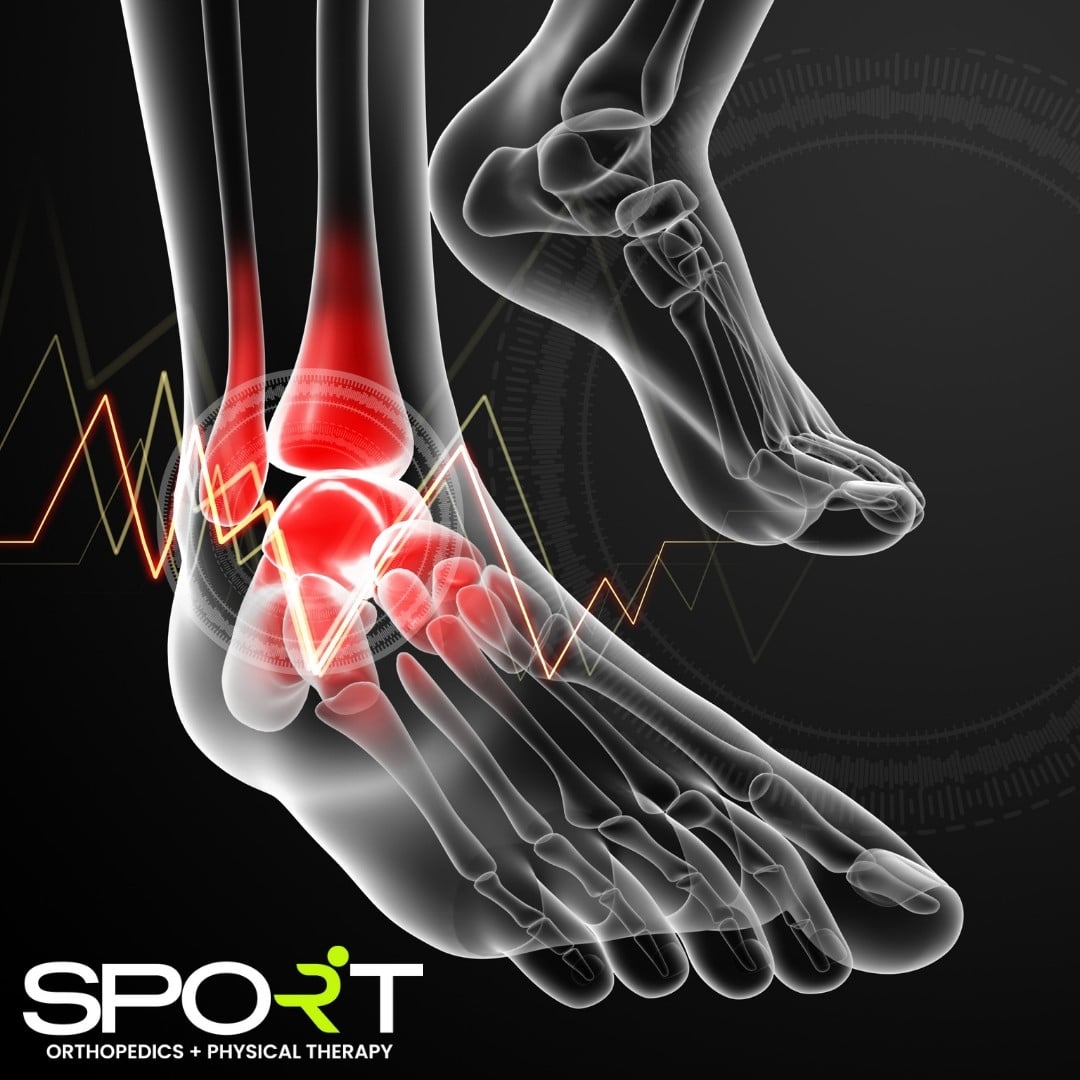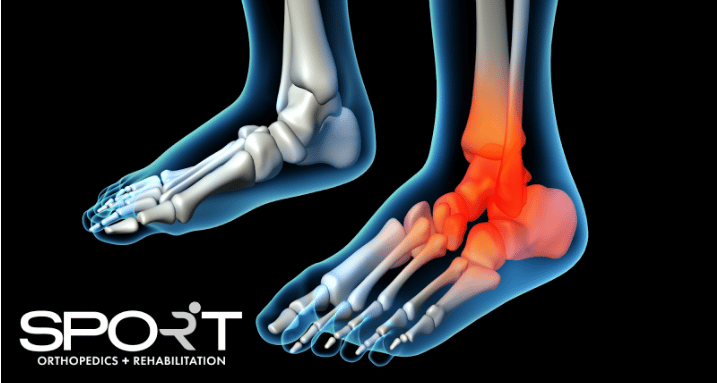Osteochondral Lesions Treatment in Dallas and Frisco, TX
Osteochondritis Dessicans, Osteochondral Lesion of the Talus (OLT)
Joints are an integral part of your body. They are made up of many moving parts, which means that there are many different ways these joints can be injured. Osteochondral lesions or osteochondral fractures are injuries to the cartilage and bone of the joint. An osteochondral lesion (or an osteochondral defect) is most common in the knee and ankle joints. Some of these injuries can heal with physical therapy, but most need surgical treatment.
Ankle injuries can cause intense pain and prevent you from doing most of your daily activities comfortably. The experienced team at SPORT Orthopedics and Physical Therapy can help you get back to your daily life. Contact a Dallas ankle orthopaedic surgeon for more information about treatment. Call us at (469) 200-2832 to schedule an appointment.
What is an Osteochondral Lesion of the Medial Talar Dome?
An osteochondral lesion of the medial talar dome may sound alarming, but let’s break down what it means. “Osteochondral” refers to the bone (osteo) and cartilage (chondral) surrounding it. The talar dome is the cartilage that covers the talus, or the bottom bone of your ankle joint. Medial refers to the inside edge of the body part, as opposed to the lateral or outside edge. So an osteochondral lesion of the medial talar dome is an injury to the cartilage in your ankle joint. Injuries to the bone and overlying cartilage can include fractures, tearing or crushing, and even cysts in the cartilage.
Anatomy
An ankle joint is made up of the tibia, fibula, and talus bones. The tibia and fibula sit on either side of the talus. The lateral malleolus and medial malleolus are the bumps on the outside of your ankle. The talus is covered in a layer of cartilage called the talar dome. This allows the joint to move up, down, and side to side. There are two common types of osteochondral lesions of the ankle. Injuries can occur with the medial talar dome (inside) and the anterolateral talar dome (outside).

Symptoms of Osteochondral Lesions
Symptoms of an osteochondral lesion can include deep ankle pain, ankle instability, swelling, and catching. “Catching” is when the ankle locks or freezes and will not bend. This could mean there is a loose bone fragment or cartilage fragment in the joint. Partial or complete detachment of talar cartilage can cause popping or clicking in the ankle joint. Many patients have no symptoms with minor osteochondral lesions.
What Causes an Osteochondral Lesion?

A single traumatic injury and repeated trauma can cause osteochondral lesions. Ankle sprains can cause an osteochondral lesion, especially if you have sprained an ankle many times. Prolonged pain after an ankle sprain could indicate an osteochondral lesion. Antero-lateral lesions are usually caused by an ankle sprain. Other traumatic twisting incidents can also cause this type of lesion. Medial talar dome lesions are often the result of overuse and many minor injuries.
Diagnosis of Osteochondral Lesions
A physical examination can help diagnose talar osteochondral lesions. Unfortunately, other injuries like ankle sprains can hide lesions of the talus. Most osteochondral lesions are diagnosed through magnetic resonance imaging (MRIs). A physical exam can be part of the diagnosis process, but imaging is often needed. MRIs and CT scans help locate the exact location and extent of cartilage damage.
Orthopedic surgeons use a staging system for osteochondral lesions. The stages are divided by the stability and severity of the injury. Stage I lesions have damage limited to the talar articular cartilage. In these cases, the collateral ligament remains intact around the injury. Stage I lesions cannot be seen on an X-Ray. Stage II includes a fracture to the bone beneath the cartilage. The third stage involves fragments of cartilage or bone. If the fragment is floating or moving in the ankle, it’s a Stage IV injury. Stage V injuries include bone cysts.
Treatment for Osteo Injury of the Ankle Joint

Treatment options for an osteochondral fracture include surgical and nonsurgical treatment options. Younger patients usually benefit more from conservative treatment than adults do. Adults are more likely to recover with a mix of conservative and surgical treatment. The ankle doesn’t have a rich blood supply, so injuries to the ankle take longer to heal.
Non-surgical Treatment
Stable lesions are treated with immobilization and physical therapy, especially in children. After a single traumatic event, a cast or protective brace can prevent the injury from getting worse. A small lesion with no bone or cartilage fragments has a better chance of healing from conservative treatment.
Surgical Treatment
Surgery is used to treat injuries from multiple traumatic events or injuries that didn’t heal with conservative treatment. It is also used to treat injuries with a loose fragment of bone or cartilage. The most common surgical treatment is arthroscopic surgery to clean out the broken fragments. This option uses tiny incisions to explore the joint.
If this option fails or if the lesion is large, an experienced orthopedic surgeon can repair the damaged cartilage and bone. Surgeons use grafts to plug the damaged area. The cartilage and bone can come from the patient (osteochondral autograft transplantation). The graft plug can also come from a cadaver (osteochondral allograft transfer).
Surgery also treats cysts associated with osteochondral lesions. Cysts can happen even with intact overlying cartilage. In severe cases, you may need lateral ligament reconstruction to repair damage to the ligaments in the ankle.
Physical Therapy
Physicians use physical therapy for both surgical and nonsurgical treatment plans. Whether you have surgery or use a cast, you can’t put weight on the injured ankle for a period ranging from a few weeks to a few months. Physical therapy helps strengthen the muscles around the ankle to prevent future injuries. It also helps increase the flexibility and motion of the ankle.
Osteochondral Lesion Specialists in Dallas and Frisco
From conservative therapy to surgical treatment, the talented team at SPORT Orthopedics and Physical Therapy can help you. Get back to living your best life with help from our team. Call (469) 200-2832 to schedule a consultation or fill out our online intake form. Don’t hesitate to schedule an appointment with our Frisco physical therapists to help you get back on your feet and back in the game.


